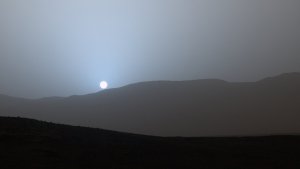| News / Space News |
Auroras on Mars
NASA | MAY 16, 2015
NASA's MAVEN spacecraft detected evidence of widespread auroras in Mars's northern hemisphere. The "Christmas Lights," as researchers called them, circled the globe and descended so close to the Martian equator that, if the lights had occurred on Earth, they would have been over places like Florida and Texas.

A map of MAVEN's Imaging Ultraviolet Spectrograph (IUVS) auroral detections in December 2014 overlaid on Mars’ surface. The map shows that the aurora was widespread in the northern hemisphere, not tied to any geographic location. The aurora was detected in all observations during a 5-day period. ![]()
This isn't the first time a spacecraft has detected auroras on Mars. Ten years ago, the European Space Agency's Mars Express found an ultraviolet glow coming from "magnetic umbrellas" in the southern hemisphere.
Unlike Earth, Mars does not have a global magnetic field that envelops the entire planet. Instead, Mars has umbrella-shaped magnetic fields that sprout out of the ground like mushrooms, here and there, but mainly in the southern hemisphere. These umbrellas are remnants of an ancient global field that decayed billions of years ago.
According to the MAVEN data, solar particles that caused the "Christmas lights" penetrated deeply into the Martian atmosphere---sparking auroras less than 100 km from the surface. That's lower than auroras on Earth, which range from 100 km to 500 km high.
YOU MAY ALSO LIKE





